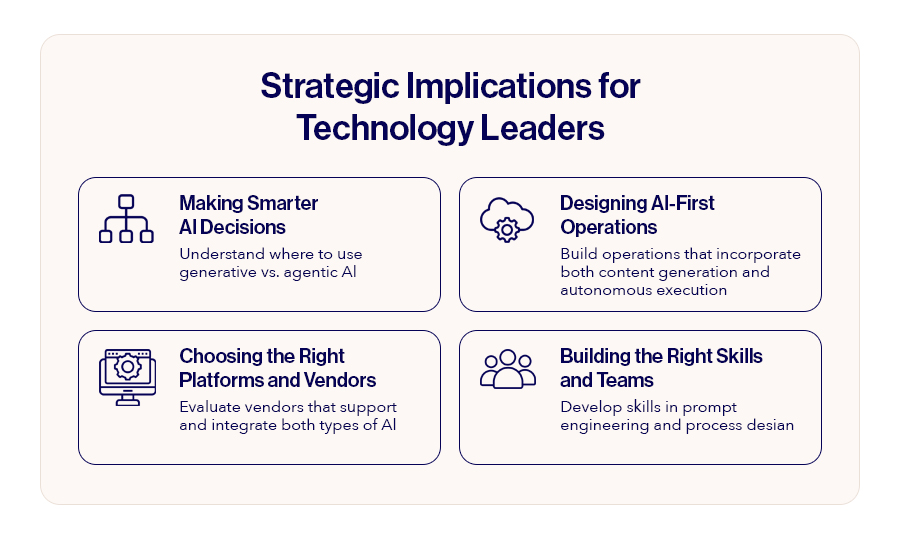Introduction
As we pass the mid-2020s, AI technologies in business have become omnipresent. Enterprises are deploying artificial intelligence not simply to automate tasks, but to fundamentally reimagine what’s possible. The surge in adoption is reflected in numbers: the global Generative AI market is projected to reach $66.89 billion in 2025, while the Agentic AI market is expected to hit $7.4 billion in the same year and skyrocket to over $171.2 billion by 2034.
“AI agents will become our digital assistants, helping us navigate the complexities of the modern world. They will make our lives easier and more efficient.” –Jeff Bezos, Founder and CEO of Amazon
With the rapidly evolving AI landscape for enterprises, there are two paradigms now shaping enterprise operations: Generative AI and Agentic AI. While Generative AI captured headlines with tools like ChatGPT, Agentic AI platforms represent the next frontier—autonomous AI systems that don't just create content but take action to achieve specific goals.
Understanding these differences isn't just academic knowledge. Organizations that grasp the unique capabilities of each can deploy the right AI solution for business challenges, maximizing both efficiency and competitive advantage. This comprehensive guide explores what sets these AI paradigms apart, when to use each, and how they work together to transform business operations through AI.

What is Generative AI?
Generative AI (GenAI) for business creates new content based on learned patterns from vast datasets. These systems excel at producing text, images, code, audio, and video by recognizing statistical relationships in their training data and generating outputs that match user prompts.
Core Capabilities
GenAI operates through sophisticated neural networks, particularly Large Language Models (LLMs) built on transformer architectures. These models process enormous amounts of training data to understand patterns, context, and relationships within information.
When a user provides a prompt, the system draws from its learned knowledge to synthesize new content that matches the request. The quality depends heavily on the training data quality and the specificity of the prompt provided.
Common Applications
- Content Creation: Marketing teams use GenAI content tools to produce blog posts, social media content, and advertising copy at scale. Tools like ChatGPT and Claude can generate human-like text for various purposes.
- Code Generation: Developers leverage platforms like GitHub Copilot to automatically generate code snippets, complete functions, and debug existing code.
- Creative Design: Image generators such as DALL-E and Mid journey create visual content from text descriptions, enabling rapid prototyping and creative exploration.
- Data Analysis: GenAI can summarize complex documents, translate content across languages, and transform technical information into accessible formats.
Key Limitations
GenAI systems are inherently reactive, responding only to direct prompts. They lack persistent memory in AI interactions and cannot initiate actions independently. These systems also require careful fact-checking, as they can produce convincing but inaccurate information—a phenomenon commonly known as AI hallucination.
What is Agentic AI?
Agentic AI for enterprises represents a fundamental shift toward autonomous AI systems that can plan, reason, and execute complex tasks with minimal human intervention. Unlike GenAI's prompt-response model, Agentic AI operates through goal-oriented behavior, making decisions and taking actions across multiple systems to achieve specific outcomes.
Defining Characteristics
- Autonomy: Agentic AI systems can operate independently for extended periods, making decisions without constant human guidance.
- Goal Orientation: These systems work toward specific objectives, adapting their approach based on changing conditions and feedback.
- Persistent Memory: Unlike GenAI, Agentic systems maintain context and learning across interactions, building understanding over time.
- Multi-step Execution: Agentic AI can break down complex objectives into sequential tasks, coordinating multiple actions across different platforms and systems.
Core Architecture Components
Agentic AI systems typically operate through four key phases: collect, reason, act, and learn. They gather data from multiple sources, analyze information to understand context, take appropriate actions, and continuously improve through feedback loops.
These systems often incorporate reinforcement learning in AI, enabling them to optimize their performance through trial and error. This learning capability allows Agentic AI to adapt to new situations and improve outcomes over time.
Enterprise Applications
- Workflow Automation: Agentic systems can manage entire business processes, from initial data collection through final reporting, adapting to exceptions and variations without human intervention.
- Customer Service Automation: Advanced AI agents handle complex customer inquiries end-to-end, accessing multiple systems, processing requests, and following up on resolutions.
- Supply Chain Management with AI: Agentic AI monitors inventory levels, predicts demand, coordinates with suppliers, and adjusts logistics in real-time based on changing conditions.
Core Differences Between Generative AI and Agentic AI
Understanding the differences between GenAI and Agentic AI is crucial for deploying the right AI tool for the right use case. Here's a side-by-side comparison:
When to Use Each Type of AI
When to Use GenAI
- You need to create a large amount of content quickly (e.g., marketing copy, documentation).
- Your workflow includes human review and editing of AI-generated content.
- The tasks are simple, single-step, and independent (e.g., summarizing, translating, code suggestions).
- You are brainstorming or exploring creative ideas (text, images, or other media).
When to Use Agentic AI
- You need to automate complex, multi-step workflows with decisions and conditions.
- Your process requires continuous monitoring (e.g., system alerts, compliance checks).
- Tasks involve coordination across multiple systems or platforms.
- The work environment often changes, and you need AI that can adapt and respond on its own.
Enterprise Use Cases
Here are a few enterprise AI use cases showing how companies are using GenAI and Agentic AI to improve different areas of their business:
GenAI in Marketing Operations
Marketing teams are using GenAI for marketing to produce content such as:
- Personalized email campaigns
- Social media posts
- Video scripts and ad copy
- Product descriptions
AI-generated marketing content allows teams to create thousands of content variations tailored to different audiences and platforms.
Human reviewers can then refine the outputs before publishing. This AI-driven content creation speeds up content production, supports rapid testing, and helps teams stay agile in fast-moving markets.
GenAI in Software Development
In software engineering, AI-powered software development with GenAI helps with:
- Code completion and generation
- Writing documentation
- Debugging and code optimization
- Creating test cases and mock data
It allows developers to turn natural language into working code, find bugs faster, and create more thorough tests. This improves both development speed and software reliability.
Agentic AI in Customer Service
Agentic AI in customer service is transforming how support teams operate by:
- Managing end-to-end customer interactions
- Connecting with multiple systems and departments
- Keeping context across long conversations
- Handling tasks like returns, scheduling, and follow-ups
Unlike basic chatbots, Agentic customer service automation goes beyond answering questions. It takes action, learns from past interactions, and delivers more personalized and consistent service.
Agentic AI in Financial Operations
In finance, AI for financial compliance and automation is used for:
- Monitoring compliance and risk
- Generating regulatory reports
- Automating investment decisions
- Adjusting portfolios in real time
It tracks transactions, detects unusual patterns, and ensures that all actions follow regulations. This helps financial teams respond quickly to market changes while staying compliant.

Integrating Generative AI and Agentic AI: The Future of Enterprise AI
The true potential of enterprise AI integration lies in leveraging both Generative and Agentic systems together. This integration combines creativity and execution, enabling businesses to generate ideas and implement them seamlessly.
Automated Reporting
Ge AI for reports creates detailed reports based on data analysis, while Agentic AI platforms distribute them, schedule follow-ups, and track action items.
Enhanced Customer Service
AI-generated customer responses are crafted by GenAI, while Agentic AI manages workflows, accesses customer data, and ensures timely resolutions.
Content Strategy Execution
AI-powered content strategies are developed by GenAI, while Agentic AI handles distribution, scheduling, and performance optimization.
Toward Fully Integrated Systems
Future AI systems will combine Generative creativity with Agentic execution, creating intelligent agents capable of thinking, creating, and acting autonomously within enterprise ecosystems. This convergence will redefine how organizations operate.
Strategic Implications for Technology Leaders
Making Smarter AI Decisions
Understanding the difference between GenAI vs Agentic AI helps technology leaders make better decisions about where and how to use each type of AI. This ensures that AI tools for business transformation support real goals.
Designing AI-First Operations
Instead of treating AI as just another tool, organizations can build AI-first business operations. That means identifying which tasks need content generation (e.g., writing or summarizing) and which ones need autonomous execution (e.g., completing multi-step workflows or making decisions).
This approach focuses on enhancing human capabilities, not just automating tasks. It allows people and AI to work together to improve speed, accuracy, and outcomes.
Choosing the Right Platforms and Vendors
Selecting technology platforms becomes more complex when both GenAI and Agentic AI platforms are involved. Organizations should look for vendors that:
- Support both types of AI
- Allow integration between content generation and task execution
- Offer flexibility to grow into more advanced enterprise automation solutions in the future
Contact us today to understand how we can help you build systems with GenAI and Agentic AI, so you continue to adapt as AI evolves.
Preparing for the AI-Driven Future
Organizations that effectively harness both GenAI and Agentic AI will gain a significant competitive advantage. They will operate more efficiently, respond faster to change, and deliver superior customer experiences.
By understanding the differences between GenAI and Agentic AI systems, and how they work well together, organization scan move from simple content creation to full automation that delivers results, follows rules, and creates real value.
Frequently Asked Questions
What is the main difference between GenAI and Agentic AI?
GenAI creates content based on prompts, while Agentic AI autonomously executes tasks to achieve specific goals. Generative AI is reactive and stateless, whereas Agentic AI is proactive and maintains persistent memory across interactions.
Can GenAI become Agentic?
GenAI models can be integrated into Agentic frameworks where they serve as content generation components within larger autonomous systems. However, GenAI alone lacks the goal-oriented behavior and multi-system coordination capabilities that define Agentic AI.
Which type of AI is better for business automation?
The choice depends on the specific use case. GenAI excels at content creation and single-step tasks, while Agentic AI is superior for complex, multi-step processes requiring decision-making and system coordination. Many organizations benefit from combining both approaches.
How do these AI types work together?
Agentic AI can utilize GenAI as a tool for content creation within broader autonomous workflows. For example, an Agentic system might use GenAI to create personalized emails while autonomously managing the entire customer communication process.
What are the risks of Agentic AI?
Agentic AI requires careful governance due to its autonomous nature. Organizations must establish clear boundaries, accountability frameworks, and monitoring systems to ensure autonomous agents operate within acceptable parameters and comply with regulatory requirements.

